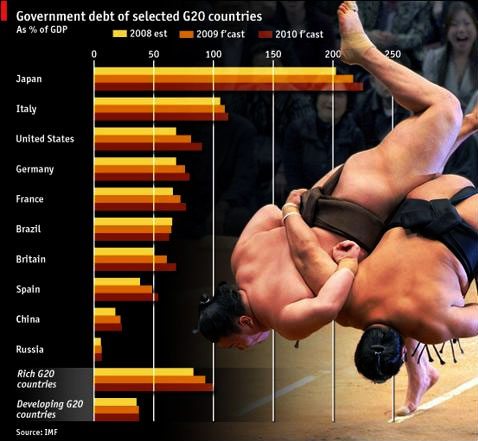Sovereign Debt = Sub-Prime DebtAcamar Journal
Mar 16, 2010
At the PDAC mining conference in Toronto last week, I thought the turnout was less than last year. This made sense, as by March 2009, investors had lost their shirts and were desperate for information on how to get their money back. Complacency has now set in with this year-long market rally.
We know that governments issued unprecedented amounts of debt to rescue the global economy from collapse.
But the crisis was caused by too much debt and leverage at a consumer and corporate level. Who will save us when government debt becomes the cause of the next crisis?
The United States is projected to run budget deficits for the next 70 years, based on long-term projections by the Congressional Budget Office. Which means it will never pay back its current gargantuan debt, and which makes the dollar vulnerable. In fact, Moodys, the debt rating service (which regrettably missed warning us about the debt crisis before it happened) is now diligently informing us that the US could lose its AAA rating.
In Europe, Standard and Poor’s (the other debt rating agency that missed the whole financial crisis as well) is now on the ball, warning that Europe needs to raise € 1.5 trillion this year.
And the games continue as well. Before 2007, there was a $ 10 trillion shadow banking system that was unregulated and leveraged, which blew up. Now we learn that Goldman Sachs helped Greece hide its deficits in order to meet Maastricht Treaty requirements and that governments, such as France and Austria, are using “alternate channels of borrowing” (such as the Société de Financement de l'Economie (SFEF) and Austria's infrastructure financing companies) to buttress state stimulus programmes with off-balance sheet funding in the tune of hundreds of billions of Euros.
In the meantime, the party continues on Wall Street. Record bonuses are being paid by zombie banks which would be extinct if not rescued by taxpayers and suspension of mark to market and other prudent rules.
Japan is mired in economic malaise and its endless stimulus programs have led to a debt to GDP ratio of over 200%.

Source: Economist.com
PIMCO, the largest bond fund manager in the world, has warned that the sovereign debt explosion has taken us into uncharted waters that threaten global economic stability.
It is inevitable that investors will want higher interest rates as this debt tsunami continues. Higher interest rates will jeopardise the economic recovery, leading governments to issue more stimulus, financed by debt! It’s a vicious cycle once it begins.
It is no wonder then that George Soros called gold the ultimate bubble. In a negative real interest rate environment, with competing currency devaluations, gold is a natural hedge.
He created some fear with his comment as some investors thought he was calling a top for gold. But all he said was it would eventually be a bubble, not that it was ready to pop. And, as he told Fareed Zakaria on CNN, he invests in bubbles to make money.
And to prove it, his Quantum fund increased its holding of the gold ETF, GLD, by 152% in Q4 2009 over Q3, to $ 672 million.
Gold is rising in all non-US$ currencies. It reflects the debasement of these paper currencies, and will reach a new high in US dollars soon.
In literature, it is important for the reader to keep his skepticism at bay in order to allow the story to unfold, a “suspension of disbelief”. We are at that stage in the global economy. This liquidity driven rally will continue as long as investors continue to act as if the recovery is real.
It is when they finally cannot bring themselves to continue to believe in the creditworthiness of various forms of paper (government bonds and currencies), when they realise it is all sub-prime in nature, that the second leg down will arrive. And this time governments will not be able to save us.
www.acamaronline.com